Odisha has become a hub for sustainable fashion with the “farm-to-fashion” concept adapted by NIFT Bhubaneswar. This makes this institution the only one in the world where students can learn the entire chain of eco-friendly fashion.
With NIFT Bhubaneswar, Odisha successfully integrated sustainability into fashion, by adopting the “farm-to-fashion” concept and has enabled students to both witness and participate in developing a garment or a decor item from yarn.
Binaya Bhushan Jena, a professor at NIFT Bhubaneswar, stated when he first walked around campus, he noticed that there were only concrete academic buildings everywhere. The city had limited exposure to the fashion industry back then and the surroundings offered little to no inspiration. This is how Professor Binaya and his team came up with the “farm-to-fashion” project which is now being adopted by other NIFT’s all over the country.
How Odisha Successfully Integrated Sustainability Into Fashion
Odisha has a long, rich heritage of using handlooms and natural dyes. This prompted Professor Binaya and his team to come up with an initiative that uses this state’s strength and merges the available space with its heritage. This ensures that sustainable fashion is unique to NIFT Bhubaneswar.
NIFT Bhubaneswar explored the possibility of creating a mini-model to demonstrate the entire eco-friendly value chain on the campus. The first step in this value chain involves sourcing the fiber. Keeping this in mind, 60 different varieties of natural dye-yielding plants and ten fiber-yielding plants that are available in Odisha, were identified with the help of local artisans and farmers. These plants have been successfully planted all over the campus.
The fiber from the fiber-yielding plants are extracted manually and then the fibers are spun into a yarn inside the looms, on the campus of NIFT Bhubaneswar. The yarn is then woven into a fabric and dyed with natural colors from dye-yielding plants. Once the fabric is ready, it is then turned into a garment.
Feeder plants like Mulberry, Arjun, and 26 Asan trees on the campus, were also planted so that there can be a full-fledged, mini-production unit of non-violent silk. Campus bee boxes were added in various corners for pollination. Compost production, rain water conservation, and perma-culture were also adopted to support this initiative.
This unique initiative has helped create opportunities for the local artisans, weavers, NGO’s, handloom clusters, and state emporiums to successfully make Odisha a hub for sustainable fashion. The biggest advantage is to students, as they can see and learn from the chain of eco-friendly fashion.
“The future of fashion rests on sustainability. This initiative will prepare the required human resources to support and drive the fashion industry. All NIFT Campuses have been asked to initiate similar “farm-to-fashion” projects based on their location, typographical uniqueness, and availability of resources,” the Ministry of Textiles added.
Demand for sustainable fashion in the World
Consumers have started becoming more aware of the planet’s needs and have started exercising their choices on what to wear and what not to wear. Textile mills are one of the top industrial polluters, as well as cause industrial water pollution.
Sustainable fashion refers to a carbon-neutral process of manufacturing textiles or accessories without harming our planet. Slowly, the demand for sustainable fashion has grown, both in domestic, as well as international markets. This has resulted in a gap between the demand and supply of sustainable fashion. One of the biggest challenges in overcoming this gap is to integrate sustainable fashion industries with eco-friendly materials and processes. This can only be achieved with extensive research, development, academics, and training.
The Ministry of Textiles stated, “We do not have institutions that offer educational programs, training, research, and development support for integration of the entire eco-friendly fashion value chain. NIFT, Bhubaneswar has created the ‘farm-to-fashion’ concept to make sustainability the future of the fashion industry.”
Apart from fashion institutes, several prominent designers in India are exploring the concept of sustainability as well. Anita Dongre, a renowned fashion designer, has designed her “Grassroot” collection that focuses on slow fashion and promotes local crafts. In 2019 and 2020, Levi’s introduced “cottonised hemp” clothing and plans to expand its collections.
With Odisha leading as the hub for sustainable fashion, it’s time for other places to step up their game. Slowly but surely, the entry of big brands into the field of sustainability can help prompt a competitive spirit that will prompt the industry to set a standard. This awareness will also prompt people to buy more eco-friendly clothes.






